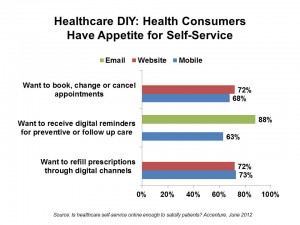 The supply-side of healthcare DIY is growing, with the advancement of Castlight Health through its $100mm VC influx and Cakehealth’s new version for managing health spending online. Consumer demand is growing, too, for these services.
The supply-side of healthcare DIY is growing, with the advancement of Castlight Health through its $100mm VC influx and Cakehealth’s new version for managing health spending online. Consumer demand is growing, too, for these services.
But don’t get over-hyped by the healthcare, everywhere, scenario. Health citizens also demand face-to-face time with their physicians and clinicians, evidenced by a survey from Accenture titled, Is healthcare self-service online enough to satisfy patients?
The answer is a clear, “no.”
90% of U.S. adults like the idea of digital health self-service, 83% want online access to personal health information, 72% want to book appointments online, as well as do e-Prescribing. Email and mobile are also important channels for self-service healthcare, as shown in the graph.
Health Populi’s Hot Points: Consider how people project-manage their reading these days. While many consumers enjoy their Kindle and Nook e-readers, they’ll still delight in going into a bricks-and-mortar Barnes & Noble or, if they’re lucky enough to have an independent bookseller in their community, one of those dying breeds of mom-and-pop shops. It’s still wonderful to hold a book-book, to sample some pages, before buying an e-book from the cloud.
Health consumers do second opinions via online, via Google and expert blogs from physicians and patient-people-like-me, and on social networks crowdsourcing health data at CureTogether, PatientsLikeMe, and WEGOHealth, among other citizen-health sites. But patients live in a health ecosystem with physicians and pharmacies, worksite clinics and retail clinics, school-based health and White Glove house calls. Health care is project-managed each day on a variety of platforms via many channels, some “live” in an office, some via videoconference, and still others via mobile.
Face-time with physicians and care providers is still highly valued by patients. Increasingly, doctors, as they grow their embrace of value-based health plans and being paid by performance and outcomes, and not for volume of patients seen in the office, will be educating patients about their options for healthcare, any- and every-where.




 Thank you, Jared Johnson, for including me on the list of the
Thank you, Jared Johnson, for including me on the list of the  I am so grateful to Tom Lawry for asking me to pen the foreword for his book, Health Care Nation,
I am so grateful to Tom Lawry for asking me to pen the foreword for his book, Health Care Nation,  Thanks to Feedspot for naming this blog, Health Populi, as a
Thanks to Feedspot for naming this blog, Health Populi, as a